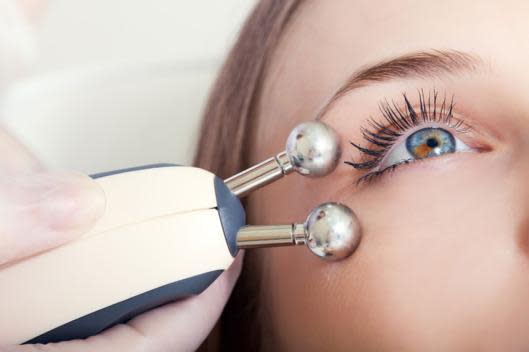Is Running Electricity Through Your Face the Secret to Youth?

Photo: putilich
By Kathleen Hou
Letting someone else run electricity through my face is a surprisingly calming experience. I’m supine, my feet propped on a goose-down pillow, wrapped in a teddy-bear-soft blanket with the air-conditioning pumped high, as Miranda Kerr’s esthetician Ildi Pekar directs microcurrents of electricity through my face. The microcurrent machine has two prongs attached to silver balls. She moves one prong along my cheekbones, pausing for a minute before gliding along to my jaw and forehead and then settling around my eyes.
Related: I Survived My Terrifying Hour in a Sensory-Deprivation Tank
Before beginning the treatment, I told her that a mini eye-wrinkle I’ve nicknamed Fred is prone to appear during bouts of fatigue or dehydration. She directs the prong to lift my eyebrow, giving me the facialist’s version of the People’s Eyebrow. Then she moves in a repeat circular pattern around my orbital bone. All in all, she spends about 30 minutes directing electricity into half my face before giving me a mirror to compare it with the untreated half.
Remarkably, the treated side looks smoother, the skin texture more silky yet firm to the touch, and my cheekbones slightly more pronounced. The untreated side looks like my face after eating night cheese — slightly more swollen, the bone structure less pronounced. Fred the Mini Wrinkle is apparent, but he’s absent on the other side. The difference isn’t big enough to create a Two-Face effect, but it’s real, and now I want that subtle, silky feeling across my whole face.
Running electricity through faces isn’t new. There are at-home personal devices that “tone” the face using electricity to dubious results. But Joanna Vargas, a celebrity facialist who counts Sofia Coppola as a client, explains that a typical professional use microcurrent machine conducts about 300 to 500 micro amps of electricity. It’s an amount so slight that it would take 1 million microcurrent machines to light a 40-watt lightbulb. “The mild electric current drains out excess water, tighten muscles, and tightens skin,” she says. “It’s like going to the gym for your face.” I’m skeptical — if you’re not sweating, it’s not the gym.
But Pekar uses the same metaphor, calling it a “personal trainer” for your face, creating one of the “most effective workouts to see the fastest results.” Both aestheticians agree that lymphatic drainage makes the effects immediate. “Microcurrent recharges your facial tissues. It also stimulates your Adenosine triphosphate [ATP, a source of energy for cellular functions] and blood circulation, which delivers a radiant appearance,” says Pekar. Vargas adds that it increases collagen production, too, bumping it up to a rate of between 10 to 15 percent higher than normal.
Related: Can Gummy Candy Make You More Beautiful?
After trying three microcurrent facials throughout the year, and witnessing three Two-Face moments, my skepticism is lightened. It’s not a workout, but after each facial, my skin tone looked more even, and unlike a facial full of extractions, they didn’t leave me angrily red. All three facials were also largely painless; in fact, in two of them I fell asleep because the prongs moving across my face felt like lying on the cool side of the pillow.
During the third facial, though, the aesthetician declared my pre-treatment face “puffy.” If the other facials were like Pilates for the skin, this was Tone House or Barry’s Bootcamp. My muscles were stretched and contorted, the prongs digging in so deeply that my face felt like Jim Carrey’s in The Mask. However, even after that contortionist facial, I looked slightly less puffy, if also less tranquil and smooth.
Though some articles tout microcurrents as an alternative to injectables and a secret to everlasting youth, dermatologists appear skeptical about the idea of “exercising” your face using electricity. Dr. Paul Jarrod Frank, who is rumored to have recently treated Madonna, says, “There are few benefits, if any, to microcurrent facials. Unlike skeletal muscles, which we can induce growth of with exercise, muscles of the face are a totally different kind and they cannot be strengthened in the same way. Microcurrent is never a preferred alternative to injectables.“
Dr. Heidi Waldorf, director of laser and cosmetic dermatology at the Mount Sinai Hospital, explains, “Our faces don’t sag because of weak muscles. They sag because we lose volume. Botulinum toxin [Botox] works by relaxing muscles.” At least both doctors agree that the risks of a microcurrent facial are minimal when performed by a professional.
Who should get a microcurrent facial? Someone who wants to see their face look visibly better in one snoozy session — and someone with money. Aestheticians agree that the results are cumulative. Celebrity aesthetician Kate Somerville has clients who come in for the procedure once a month at her Hollywood-based salon, but some come in twice a week. “For clients with great skin in their early 30s, microcurrent is a preventative treatment,” she says. If you want to experience some of these electric feels firsthand, Somerville’s Muscle Lift Facial begins at $180.
More from The Cut:
Is There Any Good Way to Go Gray in Your 20s?
What Makes Kim Kardashian’s Hair Look So Good?
Meet the Woman Who Started a Blog About Female Orgasms
25 Famous Women on Being in Charge
How to Work Out Your Whole Body in 20 Minutes

